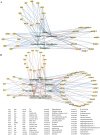The bacterial succession and its role in flavor compounds formation during the fermentation of cigar tobacco leaves
- PMID: 38647588
- PMCID: PMC10992852
- DOI: 10.1186/s40643-023-00694-9
The bacterial succession and its role in flavor compounds formation during the fermentation of cigar tobacco leaves
Abstract
Fermentation is the key process required for developing the characteristic properties of cigar tobacco leaves, complex microorganisms are involved in this process. However, the microbial fermentation mechanisms during the fermentation process have not been well-characterized. This study investigated the dynamic changes in conventional chemical composition, flavor compounds, and bacterial community during the fermentation of cigar tobacco leaves from Hainan and Sichuan provinces in China, as well as the potential roles of bacteria. Fermentation resulted in a reduction of conventional chemical components in tobacco leaves, with the exception of a noteworthy increase in insoluble protein content. Furthermore, the levels of 10 organic acids and 19 amino acids showed a significant decrease, whereas the concentration of 30 aromatic substances exhibited a unimodal trend. Before fermentation, the bacterial community structures and dominant bacteria in Hainan and Sichuan tobacco leaves differed significantly. As fermentation progressed, the community structures in the two regions became relatively similar, with Delftia, Ochrobactrum, Rhodococcus, and Stenotrophomonas being dominant. Furthermore, a total of 12 functional bacterial genera were identified in Hainan and Sichuan tobacco leaves using bidirectional orthogonal partial least squares (O2PLS) analysis. Delftia, Ochrobactrum, and Rhodococcus demonstrated a significant negative correlation with oleic acid and linoleic acid, while Stenotrophomonas and Delftia showed a significant negative correlation with undesirable amino acids, such as Ala and Glu. In addition, Bacillus showed a positive correlation with benzaldehyde, while Kocuria displayed a positive correlation with 2-acetylfuran, isophorone, 2, 6-nonadienal, and β-damascenone. The co-occurrence network analysis of microorganisms revealed a prevalence of positive correlations within the bacterial network, with non-abundant bacteria potentially contributing to the stabilization of the bacterial community. These findings can improve the overall tobacco quality and provide a novel perspective on the utilization of microorganisms in the fermentation of cigar tobacco leaves.
Keywords: Bacterial community; Cigar tobacco leaves; Co-occurrence network; Fermentation; Flavor substances.
© 2023. The Author(s).
Conflict of interest statement
The authors declare that they have no competing interests.
Figures






Similar articles
-
Study on the correlation between the dominant microflora and the main flavor substances in the fermentation process of cigar tobacco leaves.Front Microbiol. 2023 Nov 21;14:1267447. doi: 10.3389/fmicb.2023.1267447. eCollection 2023. Front Microbiol. 2023. PMID: 38075898 Free PMC article.
-
Roles of cigar microbes in flavor formation during roasted-rice leachate fermentation.Appl Microbiol Biotechnol. 2024 Sep 2;108(1):457. doi: 10.1007/s00253-024-13289-x. Appl Microbiol Biotechnol. 2024. PMID: 39222255 Free PMC article.
-
Effect of microbial community on the formation of flavor components in cigar tobacco leaves during air-curing.BMC Microbiol. 2025 Jan 31;25(1):56. doi: 10.1186/s12866-025-03774-2. BMC Microbiol. 2025. PMID: 39891085 Free PMC article.
-
Integrated microbiology and metabolomics analysis reveal the fermentation process and the flavor development in cigar tobacco leaf.Microbiol Spectr. 2025 Jun 3;13(6):e0102924. doi: 10.1128/spectrum.01029-24. Epub 2025 Apr 24. Microbiol Spectr. 2025. PMID: 40272187 Free PMC article.
-
Shaping the future of tobacco through microbial insights: a review of advances and applications.Front Bioeng Biotechnol. 2025 May 12;13:1548323. doi: 10.3389/fbioe.2025.1548323. eCollection 2025. Front Bioeng Biotechnol. 2025. PMID: 40421115 Free PMC article. Review.
Cited by
-
Unraveling the microbiome-aroma Nexus: a metagenomic and volatile compound analysis of Yunnan cigars.Front Microbiol. 2025 Jul 9;16:1597501. doi: 10.3389/fmicb.2025.1597501. eCollection 2025. Front Microbiol. 2025. PMID: 40703235 Free PMC article.
-
Application of starch-degradation bacteria in cigar tobacco leaf fermentation: effects on starch degradation, microbial communities and metabolic pathways.Front Microbiol. 2025 Jul 21;16:1632731. doi: 10.3389/fmicb.2025.1632731. eCollection 2025. Front Microbiol. 2025. PMID: 40761280 Free PMC article.
-
Fermentation process of tobacco leaves drives the specific changes of microbial community.BMC Microbiol. 2024 Dec 23;24(1):534. doi: 10.1186/s12866-024-03702-w. BMC Microbiol. 2024. PMID: 39716094 Free PMC article.
-
A comparative analysis of the microbiome of cigars produced in the Caribbean and China.Sci Rep. 2025 Aug 19;15(1):30384. doi: 10.1038/s41598-025-16199-8. Sci Rep. 2025. PMID: 40830402 Free PMC article.
References
-
- Ali H, Paetzold R, Brueckner H. Determination of L- and D-amino acids in smokeless tobacco products and tobacco. Food Chem. 2006;99:803–812. doi: 10.1016/j.foodchem.2005.08.056. - DOI
Grants and funding
LinkOut - more resources
Full Text Sources
Research Materials

